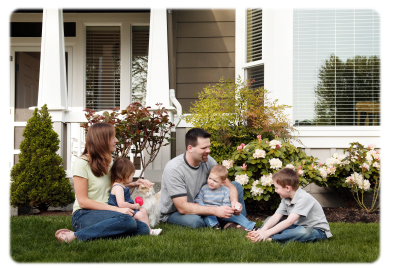NAHB

In 2008, NAHB notified the American National Standards Institute (ANSI) of its intent to develop the National Green Building Standard. In early 2007, NAHB partnered with the International Code Council (ICC) to develop a standard which was approved in January 2009. The new standard includes a list of mandatory measures, most of which correspond to minimum code requirements. Builders accrue points by incorporating features in seven areas: site design & development, lot design & development, resource efficiency, energy efficiency, water efficiency, indoor environmental quality, and operation, maintenance and owner education.
Features
The program sets point requirements in each category for the bronze, silver, gold and emerald levels. Homes are inspected and verified by local green experts and the documentation is sent to the NAHB Research Center for review. If the project qualifies, the home can receive national certification from the Research Center.
Local home builders associations will continue to provide education, advocacy and promotional assistance to their green builders using new, expanded resources from NAHB.
NAHB for Homes
The following tables highlight the point values required in each area for green buildings and subdivisions. A new threshold - “Emerald” - was added to denote the highest achievement in residential green construction.
| Threshold Point Ratings for Green Buildings | ||||||
| Green Building Categories | Performance Point Levels (1) (2) | |||||
| BRONZE E | SILVER R | GOLD D | EMERAL D | |||
| 1. | Chapter 5 | Lot Design, Preparation, and Development | 39 | 66 | 93 | 119 |
| 2. | Chapter 6 | Resource Efficiency | 45 | 79 | 113 | 146 |
| 3. | Chapter 7 | Energy Efficiency | 30 | 60 | 100 | 120 |
| 4. | Chapter 8 | Water Efficiency | 14 | 26 | 41 | 60 |
| 5. | Chapter 9 | Indoor Environmental Quality | 36 | 65 | 100 | 140 |
| 6. | Chapter 10 | Operation, Maintenance, and Building Owner Education | 8 | 10 | 11 | 12 |
| 7. | Additional Points from any category | 50 | 100 | 100 | 100 | |
| Total Points | 222 | 406 | 558 | 697 | ||
NAHB for Homes promotes the design and construction of high-performance green homes. A green home uses less energy, water and natural resources; creates less waste; and is healthier and more comfortable for the occupants.
The NAHB Green Building Standard provides credits in seven categories:
Site Design Preparation & Development – A builder can influence not only the resource efficiency of each particular home but also a community or subdivisions overall environmental impact. Low Impact Development (LID) is one approach to “Green” site development.
Lot Design Preparation & Development – Design principles such as saving trees, constructing onsite storm water retention & infiltration features, and orienting houses to maximize passive solar heating and cooling are basic processes used in the design and construction of green homes.
Resource Efficiency Creating resource efficient designs and using resource efficient materials can maximize function while optimizing the use of natural resources. It is also about reducing jobsite waste which helps to reduce the quantity of landfill material.
Energy Efficiency – The greatest improvements result from a “whole systems” approach. Energy performance does not end with increased R-values, the use of renewable energy, and/or more efficient HVAC equipment. Rather, there needs to be a balance between these features and careful window selection, building envelope air sealing, duct sealing, and proper placement of air and vapor barriers from foundation to attic to create a truly high-performance, energy efficient home that is less expensive to operate and more comfortable to live in than a conventionally constructed home.
Water Efficiency – More efficient water delivery systems indoors and native and drought-resistant landscaping choices outdoors can help prevent unnecessary waste of valuable water resources.
Indoor Environmental Quality –There are measures that can mitigate the effects of potential contaminants including controlling the source, diluting the source, and capturing the source through filtration.
Operation, Maintenance & Homeowner Education– By providing homeowners with a manual that explains proper operation and maintenance procedures, offers alternatives to toxic cleaning substances and lawn and garden chemicals, and points out water-saving practices, a builder can help assure that the green home that was so carefully built will also be operated in an environmentally responsible manner.
What specific elements within each category shown contribute to earning NAHB points when VERSATEX trim is used?
Resource Efficiency:
Practice 601.7 – Building materials/assemblies do not require additional site applied material for finishing. Receive five points when 90% or more of the installed trim is VERSATEX. Earn two points when more than 50% but less than 90% of the installed trim is VERSATEX.
Practice 602.8 – VERSATEX qualifies as a termite resistant exterior cladding material and is eligible for two, four or six points depending on the degree of termite infestation probability (slight, moderate or heavy).
Practice 605.3 – VERSATEX trim is taken from a project and recycled. If a minimum of two types of materials are recycled off site - 3 points. For each additional recycled material - 1 point.
Practice 608.1 – Material that originates, is produced, grows naturally or occurs naturally (Indigenous materials) in a region within 500 miles of the construction site. If your project falls within 500 miles of the VERSATEX plant you qualify for two points.
Practice 609.1 – VERSATEX qualifies as a more environmentally preferable product or assembly based upon the use of life cycle assessment (LCA) practices - 3 points.
Primary Benefits to Owners of “Green” homes:
- Lower operating costs due to water and energy efficiency measures.
- Increased comfort due to consistent temperatures, fewer drafts and improved humidity control.
- Improved environmental quality by reducing moisture in and around the home, as well as reliance on materials containing chemicals thus producing a healthier indoor environment.
- Longer lasting more durable materials require fewer resources for replacement while reducing repair and maintenance costs.

